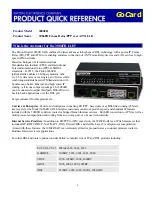
3Com Switch 8800 Configuration Guide
Chapter 27 IGMP Configuration
27-1
Chapter 27 IGMP Configuration
27.1 IGMP Overview
27.1.1 Introduction to IGMP
Internet Group Management Protocol (IGMP) is a protocol in the TCP/IP suite
responsible for management of IP multicast members. It is used to establish and
maintain multicast membership among IP hosts and their directly connected
neighboring routers. IGMP excludes transmitting and maintenance of membership
information among multicast routers, which are completed by multicast routing
protocols. All hosts participating in multicast must implement IGMP.
Hosts participating in IP multicast can join and leave a multicast group at any time. The
number of members of a multicast group can be any integer and the location of them
can be anywhere. A multicast router does not need and cannot keep the membership of
all hosts. It only uses IGMP to learn whether receivers (i.e., group members) of a
multicast group are present on the subnet connected to each interface. A host only
needs to keep which multicast groups it has joined.
IGMP is not symmetric on hosts and routers. Hosts need to respond to IGMP query
messages from the multicast router, i.e., report the group membership to the router.
The router needs to send membership query messages periodically to discover
whether hosts join the specified group on its subnets according to the received
response messages. When the router receives the report that hosts leave the group,
the router will send a group-specific query packet (IGMP Version 2) to discover whether
no member exists in the group.
Up to now, IGMP has three versions, namely, IGMP Version 1 (defined by RFC1112),
IGMP Version 2 (defined by RFC2236) and IGMP Version 3. At present, IGMP Version
2 is the most widely used version.
IGMP Version 2 boasts the following improvements over IGMP Version 1:
I. Election mechanism of multicast routers on the shared network segment
A shared network segment means that there are multiple multicast routers on a network
segment. In this case, all routers running IGMP on the network segment can receive
the membership report from hosts. Therefore, only one router is necessary to send
membership query messages. In this case, the router election mechanism is required
to specify a router as the querier.
In IGMP Version 1, selection of the querier is determined by the multicast routing
protocol. While IGMP Version 2 specifies that the multicast router with the lowest IP
















































